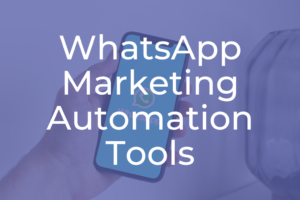
In today’s digital age, WhatsApp has emerged as a powerful platform for direct marketing, thanks to its vast global user base and personal engagement capabilities. Leveraging WhatsApp for marketing allows businesses to connect with their customers on a platform they use daily, offering unprecedented opportunities for personalized communication and engagement. To harness this potential effectively, many companies turn to WhatsApp marketing automation tools. These tools automate interactions, send timely notifications, and provide personalized customer service, thereby enhancing customer experience and engagement. Let’s explore some of the leading WhatsApp marketing automation tools and outline the steps involved in creating a successful WhatsApp marketing automation strategy.
Leading WhatsApp Marketing Automation Tools
1. Aisensy
Aisensy is designed to automate WhatsApp marketing campaigns, making it easier for businesses to reach out to their target audience on WhatsApp at scale. It allows for the automation of sending messages, managing campaigns, and segmenting audiences, ensuring that personalized content reaches the right people at the right time. Aisensy’s analytics features also help businesses track the effectiveness of their campaigns, providing insights into message read rates, engagement levels, and conversion rates.
2. Botpress
While primarily known as an open-source conversational AI platform, Botpress can be utilized to create intelligent WhatsApp bots. These bots can automate customer service, lead generation, and even conduct surveys. Botpress’s strength lies in its advanced natural language processing capabilities, allowing for more natural and engaging conversations with users. By integrating Botpress with WhatsApp, businesses can develop sophisticated chatbot solutions that can handle a wide range of customer interactions automatically.
3. WATI
WATI (WhatsApp Team Inbox) is a customer engagement platform built on the WhatsApp Business API. It focuses on enabling businesses to manage customer communications at scale. With WATI, companies can automate responses, send bulk notifications, and provide personalized customer support through WhatsApp. Its team inbox feature also allows multiple team members to manage conversations, ensuring that customer queries are addressed promptly and efficiently.
Steps in Creating a WhatsApp Marketing Automation Strategy
Step 1: Choose the Right Tool
Select a WhatsApp marketing automation tool that fits your business needs. Consider factors such as ease of use, integration capabilities, the scale of automation, and the level of personalization it offers.
Step 2: Obtain WhatsApp Business API Access
To automate WhatsApp messaging at scale, you’ll need access to the WhatsApp Business API, which is available through the WhatsApp Business Platform. This step involves submitting an application and getting approval from WhatsApp, a process that can be facilitated by your chosen automation tool provider.
Step 3: Define Your Objectives
Clearly define what you aim to achieve with WhatsApp marketing automation. Objectives can range from increasing sales, improving customer service, to boosting engagement. Your goals will guide the design of your automation workflows.
Step 4: Segment Your Audience
Segment your audience based on demographics, behavior, or any other relevant criteria. This enables you to personalize your messaging and ensure that your communications are relevant and engaging to each segment.
Step 5: Design Your Automation Workflows
Based on your objectives and audience segments, design automation workflows that specify when and what messages should be sent. This could include welcome messages, follow-up messages after a purchase, reminders, or promotional messages.
Step 6: Create Engaging Content
Develop content that is engaging, concise, and delivers value to your audience. Use multimedia elements like images and videos to enhance your messages and make them more engaging.
Step 7: Test and Optimize
Before launching your campaign, test your automation workflows to ensure they operate as intended. Once your campaign is live, continuously monitor its performance and optimize based on feedback and analytics.
Step 8: Ensure Compliance and Respect User Privacy
Adhere to WhatsApp’s policies and local regulations regarding automated messaging and data protection. Always obtain consent before messaging users and provide an easy option for them to opt-out.
Conclusion
WhatsApp marketing automation presents a tremendous opportunity for businesses to enhance their customer engagement and drive growth. By choosing the right tools like Aisensy, Botpress, and WATI, and following a structured approach to developing your WhatsApp marketing automation strategy, you can unlock the full potential of this powerful platform. Remember, the key to success lies in personalization, timely communication, and respecting user privacy and preferences.

Ranjan is a Data Scientist, Blogger, and YouTuber. He runs DataActs, an agency focused on providing MarTech and Data solutions. On his blog and YouTube channel, ScaleHacks, he shares easy-to-understand tips on how to scale a business by leveraging Data and AI.
